Abstract
Tribology is related to all studies on friction, wear, and lubrication. One of the main aims of these studies is a reduction in friction and wear. Tribology is extremely vast, being also multidisciplinary and interdisciplinary. Therefore, it is very difficult to organize the several tribology subjects in an unique way and different classifications have been proposed by different authors. In this work, several subjects treated by tribology are reviewed and organized in six branches: Fundamental Tribology, Tribology of Materials and Lubricants, Micro and Nanotribology, Industrial Tribology, Biotribology, and New Frontiers of Tribology. The main subjects treated by the six branches are briefly reviewed in this paper in order to highlight the vastness of tribology and its important contribution to sustainability. Particularly, friction and wear reductions are strictly related to greater efficiency and material saving, which means less energy losses and material wastes, less pollution and therefore a more sustainable life according to the sustainable development goals. The connections among the latter and the several different tribological subjects are discussed.
1. Introduction
Tribology is a multidisciplinary and interdisciplinary science that deals with all problems related to friction, wear and lubrication. Principles and applications of tribology reoccur up to the prehistoric epoch. The generation of fire thanks to the friction among stones or wood and the use of rolling elements or fluids to reduce friction are just a couple of examples [1]. In spite of this, the word tribology is relatively recent, being historically connected with the so called “Jost Report” dated 1966 [2], where tribology is defined as “the science and technology of interacting surfaces in relative motion and of the practices related thereto”. In the report, the huge costs related to friction and wear, and therefore the importance of the tribological researches, are highlighted. Tribology today involves many research fields that can be considered as belonging to several different domains such as physics, chemistry, materials science, chemical engineering, biomedical engineering, mechanical engineering, manufacturing, mathematics and computer science, being connected to both fundamental and applied sciences. Some milestones of tribology, ranging from the practical use of a fluid for lubricating contacts and rolling bearings until to the use of new techniques as electronics, information and communications technology, passing through the fundamental studies on friction and lubrication, are schematically shown in Figure 1.
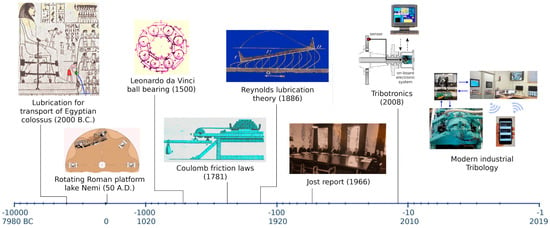
Figure 1.
Tribological milestones. From [3].
Due to the several matters investigated, the literature on tribology is huge, including books, for instance [4,5,6,7,8,9,10,11,12,13], and a number of journals and proceedings of conferences.
The vastness of the subjects studied by tribology can be seen in particular by looking at the proceedings of the World Tribology Congresses that have been held every four years since 1997, that often are only books of abstracts due to the number of works included in them [14,15,16,17,18,19,20]. Tribological studies range from theoretical to experimental ones, as well as from basic to applied researches, covering aspects from the nano world up to the macroscopic one. Therefore, it is very complex to classify the different tribology subjects. Different classifications were proposed by different researchers with new disciplines arising during the years when the number of studies in a specific research area became significant. The numerousness and, at the same time, the connections among the subjects (Figure 2) make some overlapping among the tribological disciplines unavoidable. A possible schematic classification in six branches was proposed in the work presented in [21]: fundamental tribology, tribology of materials and lubricants, micro and nanotribology, industrial tribology, biotribology, and ecotribology.
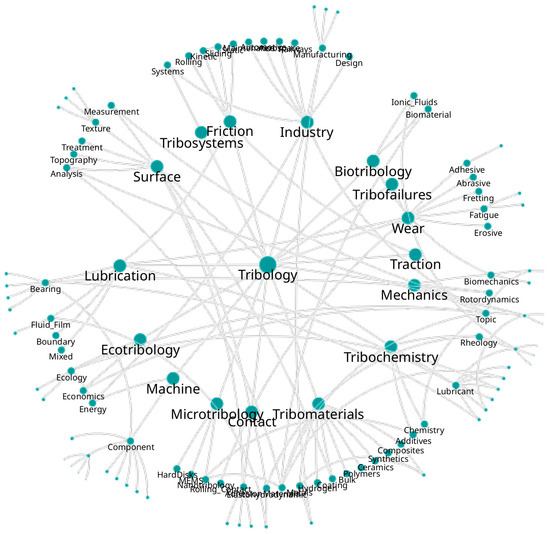
Figure 2.
Tribology subjects; an example of possible connections. Graph generated by a purposely developed Content Management Software (alfa version) used with a database of tribological keywords.
Tribology can provide enormous contributions to industrial applications as well as to many common activities of our everyday life. Just to mention some examples, a correct design of new machine components must take into account tribological aspects, usually in order to obtain reductions of friction and wear. Friction and wear problems are also involved when washing our teeth or combing our hair, and friction between our shoes and the soil should by high enough to avoid slipping. Friction and wear reductions are strictly related to greater efficiency and material saving, which means less energy losses and material wastes, less pollution and therefore a more sustainable life according to several of the 169 targets of the 17 sustainable development goals (SDGs) [22,23].
The main aim of the paper is to highlight how various and numerous the subjects investigated by tribology are, and their important contribution to sustainability. It is not the intention of the author to make an extensive review of the tribological studies, also because there is a number of review papers already available in the literature (see for instance the work presented in [24,25,26]). However, some fundamental works and several recent reviews on specific topics are cited in this paper, to which the reader can refer to for more in-depth information. The classification proposed in the work presented in [21] is used as a starting point for a deeper survey of the several subjects treated by tribological studies. This schematic review is used to evidence the relationships between tribology and the targets of the SDGs.
2. Vastness of the Tribology Subjects: A Possible Classification
The vastness of the subjects treated by tribology can be deduced by some reviews of recent advances in tribology [24,25] where research related to several different aspects of tribology performed during about the last 4–5 years is reported. In these reviews, a main subdivision is made among lubrication, wear and surface engineering, biotribology, high temperature tribology, and computational tribology. Despite the very large number of references (more than seven hundred in the first paper, and more than a thousand in the second one, over 150 pages long), the authors themselves have stated that there can be limitations in the reviews because of the multidisciplinarity of tribology, that makes its results spread across various disciplines, and because of the numerousness of the topics studied by tribology, so that many additional aspects are not covered in the reviews. A different classification of the tribological researches has been more recently used in the work presented in [26]: tribodynamics, electro-tribodynamics of modern propulsion systems, tribology of engineered surfaces, artificial intelligence in tribology, biotribology and biomimetics, nanotribology, computational and multi-scale tribology, tribology in space and other extreme environments, measurements monitoring and tribo-sensing.
The already mentioned classification of the six tribology branches (or disciplines) proposed in the work presented in [21] has been revised in this work, particularly by substituting “Ecotribology” with “New Frontiers of Tribology”, as reported in Table 1. The reason for this is that almost all tribological studies are intrinsically ecological, one of their main targets friction and wear reduction, which is related to energy and material savings, as evidenced in the next section. At the same time, new directions, trends, and developments have arisen that can be better included in the new proposed branch. The first three tribology branches can be considered more general (or basic) and the second three more specific (or applicative). However, this is only an indicative subdivision, being all basic branches connected to applications. There are also unavoidable intersections among the branches as will be shown in the following. Studies of all branches can be both experimental and/or theoretical/numerical.

Table 1.
Classification in tribology branches.
Tests can be performed, sometimes based on theoretical predictions, or for validation of the numerical results, also allowing for the calibration of empirical constants often present in theoretical models.
The main subjects treated by the six disciplines of Table 1 are described in the following.
2.1. Fundamental Tribology
This branch includes all basic studies on friction, wear and lubrication.
Theoretical models for dry friction and wear range from very simple to extremely complex involving a lot of equations. Equations for studying lubricated contacts are well established today, but their numerical solutions can be difficult, particularly in including some usually neglected aspects that can become important for certain lubricated pairs under severe working conditions. Typical examples are the thermal and deformation effects, the mixed lubrication conditions, and the combination with the friction and wear phenomena. Contact mechanics studies are also part of this branch. The applicability of some classical formulas is questionable for some particular contacts, as evidenced experimentally in the work presented in [27], while the formulas can be implemented in modern programs to allow a more comprehensive analysis [28]. Molecular dynamics simulations can also be considered among the fundamental studies, but they can also be included in the Tribology of Materials and in the Lubricants and Micro and Nanotribology branches, similarly to all basic studies on different materials and lubricants up to the micro-nano level.
A lot of basic experimental tests can be performed with tribometers of every kind. They are normally used for investigating friction and wear under dry and lubricated conditions, and lubricant film thickness. One of the today’s most used methodology for investigating the lubricant film shape in elastohydrodynamic contacts is optical interferometry, as reported in the pioneering works of Gohar and Cameron [29,30]. An example of interference image (recorded in the tribology laboratory of the University of Pisa) and the related three-dimensional shape of the lubricated contact are shown in Figure 3.
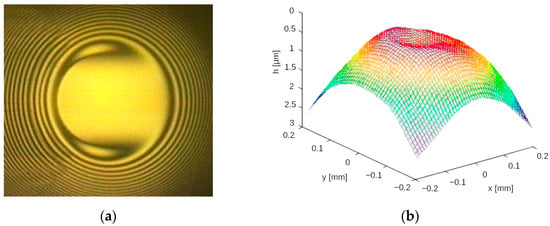
Figure 3.
Optical interferometry used for film thickness measurement: (a) Interference image of a lubricated contact between a steel ball and a glass disc obtained with monochromatic yellow light; (b) 3D reconstruction of the contact.
The outcomes of the fundamental tribological studies are used in all other branches.
2.2. Tribology of Materials and Lubricants
Research principally focused on the development of materials, surface treatments, textures and coatings, lubricants and additives can be included in this branch.
Polymers and ceramics, self-lubricating materials, surface coatings, treatments and textures are studied and their tribological behavior under both dry and lubricated conditions is investigated. A review on recent coatings of superior properties is reported in the work presented in [31]. Advances in additive manufacturing help in introducing new materials today. New surface coatings, particularly polymers (see for instance the work presented in [32]), are investigated for a bigger reduction in friction and wear. An overview of conventional polymer matrices together with a classification of fillers and filler materials is shown in Figure 4.
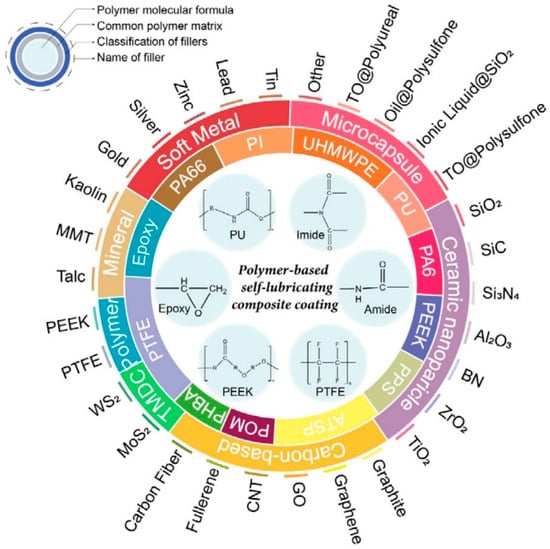
Figure 4.
Common matrices and fillers of polymer composite coating. From [32].
Reviews of the effects of surface textures and coatings materials on friction reduction and on the performance of sliding bearings are reported in the work presented in [33,34].
Nano- and biomaterials are also investigated (obviously involved in the Micro and Nanotribology and in the Biotribology branches too). Some examples are the use of nanoparticles for increasing the resistance of the materials, new 2D materials such as graphene, bioinspired materials derived from living nature (usually with less problems of toxicity).
The characteristics of commonly used lubricants as mineral oils are also improved, maybe introducing new additives, for instance to increase their durability and to reduce friction and wear in the lubricated pairs. So-called smart fluids are investigated as the electro-rheological (ER) and the magneto-rheological (MR) fluids, fluids that can vary their viscosity upon the application of an electric or magnetic field, respectively.
2.3. Micro and Nanotribology
Micro and Nanotribology deals with studies at micro and nano level.
Numerical studies are performed using molecular dynamics simulations. Molecular dynamics allows investigations on atomic-scale mechanisms of fluids at different temperature and stress conditions. A review of molecular dynamic simulations of some ionic lubricants is reported in the work presented in [35].
Research has been performed on nano-reinforced materials, hydrogenated diamond like carbon coatings, fullerene-like hydrogenated carbon film, and on the already mentioned graphene, a two-dimensional material with a layered honeycomb structure [36]. Particularly, two-dimensional materials have gained an increasing interest since the discovery of graphene in 2004. Among them it is worth mentioning MXenes, transition metal nitrides and carbides [37], and quantum dots [38], used in coatings, pure or in composites (like MXenes/polymers) and as liquid additives in lubricants. A review of nanomaterials for lubricating oil applications, particularly for friction and wear reduction, are reported in the work presented in [39,40].
Hydration lubrication [41] is another subject of increasing interest today. By combining the benefits of polymer brushes with the highly hydrated nature of some monomers, important advantages in designing extremely efficient boundary lubricants can be obtained. The lubrication by brushes is schematically shown in Figure 5.
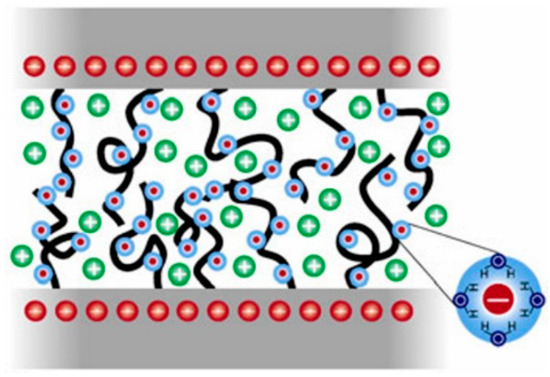
Figure 5.
Illustrating schematically the origin of the lubrication by charged brushes. From the work presented in [41].
Another interesting concept is the one of superlubricity. This term is used to describe the lubrication states with a friction coefficient of 0.001 or lower [42]. Superlubricity of solids, such as the ones in diamond-like carbon coatings or in two-dimensional materials, like graphene [43] and carbon nanotubes, and the superlubricity of liquids (in acid basic solutions, ionic liquids, and hydration layers) are investigated in particular.
The results of the research of this branch can be used for device miniaturization whose applications can be found in medicine, biotechnology, optics, aviation, electronics, etc., (see for instance the work presented in [44]).
2.4. Industrial Tribology
Industrial tribology is focused on the applications of tribological results to industrial products and manufacturing. The world is full of various machines containing moving parts in dry or lubricated contact where tribological aspects are fundamental. Common machine components, such as bearings and gears, particularly related to transports are continuously investigated in order to reduce their weight, to test new materials and lubricants, and to increase their performances. An example of research on full scale industrial components is reported in the work presented in [45]. Tilting pad journal bearings for turbomachinery of big dimensions are tested using the complex test rig shown in Figure 6.
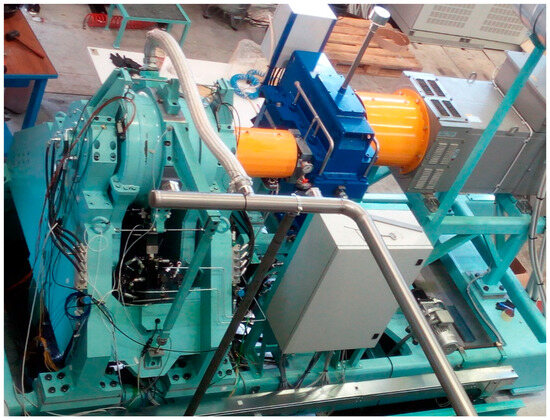
Figure 6.
Photograph of experimental apparatus for testing full scale pad journal bearings. From the work presented in [45].
It is worth mentioning that there are also applications where an increase of friction is requested instead of the usual reduction. For instance, tailored surface textures for intentionally increasing friction in road-tire contacts and movement transmission and control are reviewed in the work presented in [46].
The contributions of tribology in manufacturing (metal forming, minimum quantity lubrication (MQL) [47]), and in maintenance, monitoring, and diagnostics [48,49] are numerous. Manufacturing activities, such as grinding, turning, and cold/hot forming can take advantage of tribological results for the extension of tool lifetime with suitable coatings, and for the reduction of the amount of cutting fluids necessary, for which MQL studies are important, both with conventional and nanoparticle-enriched cutting fluids (Nano Minimum Quality Lubrication, NMQL [50]). Additive manufacturing processes are becoming more important today. A comprehensive overview of tribological research in the field of additively manufactured components is reported in the work presented in [51]. The possibility of remanufacturing worn machine components, for instance, bearings and gears that reduce waste and emissions compared with the production of new parts, must be taken into account starting from the first steps of a correct tribological design.
Condition monitoring techniques can allow an early detection of wear problems, often thanks to temperature or vibration measurements, or checking the lubricant condition, avoiding greater problems as catastrophic breakages. Smart tribological systems (sensors, actuators) are used to improve the performances of industrial machinery. The inclusion of the tribological outcomes in the maintenance procedures can play an important role in extending the lifetime of systems. New bearings, surface treatments, and lubrication systems are studied for industrial applications for which reduced maintenance is requested, in particular for renewable energy systems such as the wind turbines, where the gearbox and some bearings are located inside the nacelle that is not easy to reach (as shown in Figure 7). Wind turbines can face various tribological problems related to water contamination, wear of gearbox bearings, and gears and blades’ erosion (a review of wind turbine bearings’ failures, also with applications of fault diagnosis methods are reported in the work presented in [52]).
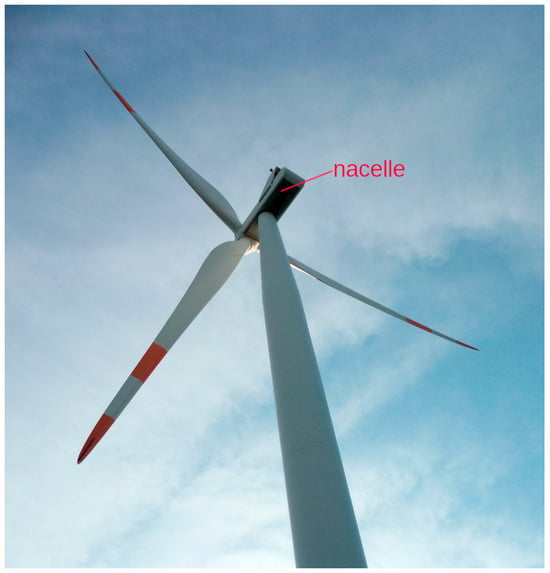
Figure 7.
Wind turbine. Wind farm of Santa Luce, Pisa.
2.5. Biotribology
The term biotribology was coined by Dowson in the 1960s [53]. The first studies in this field were performed on hip joints by medical practitioners such as Charnley [54], who then started his collaboration with mechanical engineers, among which Dowson was surely a pioneer [55,56]. In a broader sense, biotribology deals with all tribological aspects related to the living organism, both animals and plants, and includes biomedical tribology and biomimetics, as well as biomaterials and biolubricants.
Biomedical tribology involves all research more focused on humans. It can be subdivided in joints tribology (natural synovial joints, articular cartilage, artificial joints), skin tribology (skin friction behavior, tactile perception, textile material, prosthesis, hard and soft tissue substitutes), oral tribology (natural teeth, tongue, saliva, implant teeth), and ocular tribology (e.g., gelatin based soft lubricants for contact lenses). Studies on the complex lubricated friction situation of the contacts among different foods entering the oral cavity and teeth, tongue and palate are reviewed in the work presented in [57]. A review on dental tribology, including tribological aspects of human teeth, materials and friction, wear and lubrication aspects is reported in the work presented in [58], while particular attention is given to the dental resin composites in the work presented [59]. Several different biotribological issues can be involved in commonly used medical devices, such as artificial joints, dental restoration devices, skin-related devices, cardiovascular devices, and fracture fixation devices [60]. For instance, the combination of musculoskeletal dynamics with tribological investigation in total hip replacements is investigated in the works presented in [61,62]. The complexity of the evaluation of wear of hip prostheses due to daily living activities is evidenced in the work presented in [63]. The procedure adopted in this study is schematically shown in Figure 8.
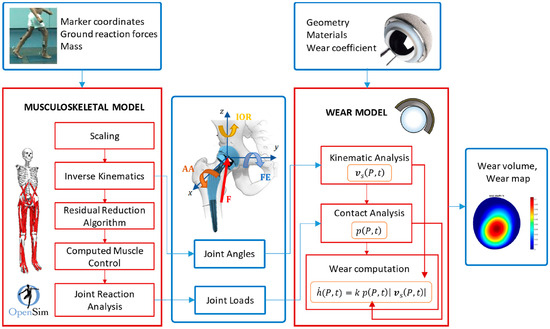
Figure 8.
General flow chart of the musculoskeletal-wear modeling procedure. From [63].
Biomimetics is related to new materials and systems that take inspiration from nature. Bio-inspired manufacturing allows the replication of natural structures. Some significant examples are: the generation of specially structured surfaces replicating the gecko toes for controlling adhesion; the replication of the nanostructure of cigada wings to obtain water-resistant and water-proof materials; the realization of non-adhesive surfaces simulating the lotus leaves and of bionic surface structures based on the epidermis of sandfishes; the mimicking of the special micro-textures with bumps and grooves of the surfaces used against sand erosion by the desert scorpions; and of the shark-skin’s texture for suppression of turbulence [64].
Research on biomaterials and biolubricants, rapidly biodegradable and non-toxic to living organisms, are often also classified as a part of another specific discipline named ecotribology (see next section). New ecofriendly lubricants and additives, such as vegetable oil-based ones, ionic liquids, coatings made by biofilms, bio-based hydraulic and metal working fluids are under study.
Vegetable oils have interesting properties, such as high biodegradability, low environmental pollution, low toxicity and high viscosity indices, but low thermal stability and poor corrosion protection. Advantages and disadvantages of biolubricants, particularly on the ones generated from biomass and other wastes, are reviewed in the work presented in [65], while an overview of functional biolubricants is given in the work presented in [66]. The life cycle of biolubricants, important for the circular economy, is shown in Figure 9. Water can be also directly used as a lubricant. A review on water-lubricated bearings is reported in the work presented in [67].
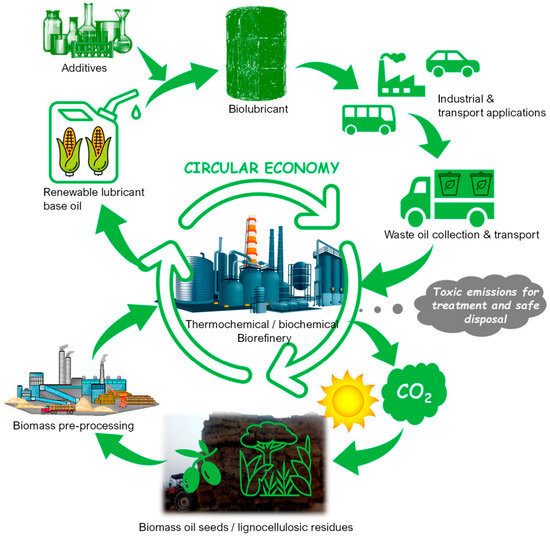
Figure 9.
Life cycle of of biolubricants. From [65].
2.6. New Frontiers of Tribology
Some modern developments not included in the previous disciplines can be considered in this branch. They are subjects that have had a renewed impulse during the recent years or matters quite new for tribology.
To put a bigger focus on the effects of the tribological studies on the environment, terms as environmental friendly tribology, ecotribology, sustainable tribology and green tribology were also introduced [64,68,69]. Actually, the ecological concepts are already included in almost all subjects of the previous tribological disciplines. The tribological studies are simply considered from a different point of view when speaking about green tribology.
Wear can be controlled through a good design of machine components, taking into account tribological aspects, as well as by means of condition monitoring of machines in order to promptly take corrective actions by reducing energy losses and the consequent emissions related to machine malfunctioning, and by avoiding catastrophic damages reducing the need for spare parts and downtime. In particular, monitoring of temperatures, vibrations, and sound emissions with online sensors connected to suitable control units and computers is employed to check the tribological status of the systems by providing information on both lubricant and component wear conditions. The contribution of electronics is also important in this case, and the term tribotronics was introduced by combining tribology and electronics to characterize this particular research field [70].
Tribological databases have been created from several sources, as experimental results of every kind, on field measurements, condition monitoring. They can furnish fundamental tribological data to be used, for instance, for extending the lifetime of machines, and they can be used to analyze the monitored data to modify almost in real time the working parameters through suitable actuators. The term triboinformatics has also been coined to better associate the efficient methods of information technology for generation, collection, processing, and analyses of tribological data [71]. Among the standard tribology information methods, artificial neural network (ANN) is one of the most used, as shown in Figure 10. The multiple interactions present in the tribological processes can be better understood by using artificial intelligence (AI) and machine learning (ML) techniques. Reviews showing applications of AI and of ML in tribology are shown in the works presented in [72,73], respectively.
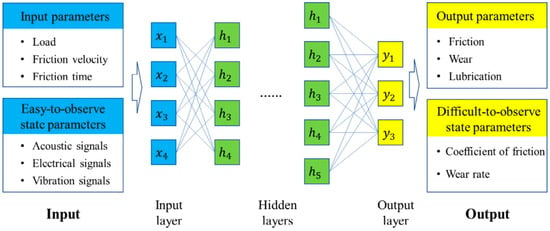
Figure 10.
Application of ANN methods in tribology research. From [71].
Extreme environments tribology includes studies about the tribological behavior of materials, lubricants, and contacts in particular situations, as in space or at high temperatures. A review on solid lubricants and self-lubricating composites used particularly at elevated temperatures is provided in the work presented in [74].
3. Tribology and the Sustainable Development Goals
As it should be already evident from the previous sections, tribology can provide large contributions for sustainable development, being fundamental for energy saving and renewable energy and human health (reduced pollution, biotribological applications).
The 17 SDGs, whose icons are shown in Figure 11, push towards a better quality of life for everybody, improving health, education, and economic conditions. They are also strictly connected with a sustainable management of the earth’s natural resources.
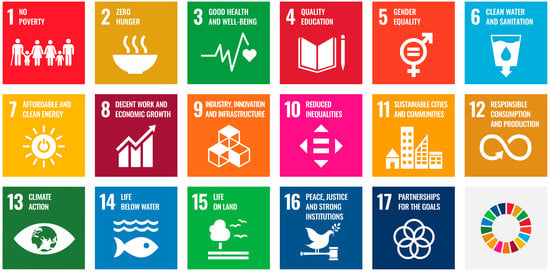
Figure 11.
The Sustainable Development Goals [75].
Tribology is very important for sustainable development. The environmental, economic, and social impact of tribology has been quantified in several studies, as for instance in the work presented in [68,69,76,77,78]. All the SDGs are directly or indirectly influenced by tribological outcomes. In particular, several targets of goals 3, 6, 7, 8, 9, 11, 12, 13, 14 and 15 are directly affected by the tribological applications as reported in the work presented in [21]. The reduction of fuel consumption, and therefore of greenhouse gases emission, the increase of machines durability, and the improvement of the quality of life through better artificial implants are some examples of how tribology can have an impact on the SDGs. Goal 12, Responsible Consumption and Production, is probably the most affected by tribology. Its targets include the efficient use of natural resources, sustainable consumption and production, and the significant reduction of release to air, water, and soil.
The connections among some tribological subjects and the relevant targets of the SDGs are reported in Table 2.

Table 2.
Tribology contributions to the Sustainable Development Goals and Targets.
The main pertinent branches are also indicated in the table. Note that Fundamental Tribology and New Frontiers of Tribology are not included, simply because they affect everything. It is evident that there is some overlapping among some of the targets and therefore some tribological subjects are connected with more than one target.
4. Discussion and Conclusions
Tribology has a big impact on sustainability.
Environmental effects of friction and wear are numerous. The more energy necessary for inefficient machinery to operate is related to a greater use of fossil fuel, affecting the limited natural resources of the earth, and producing more pollution. Friction and wear can also generate cracks in pipelines, pouring oil into the environment. Friction and wear reduction through new materials can have an influence on material footprint and efficiency, as well as on resource consumption and recycling. Not only a friction reduction can be important, in some cases an increase of friction can be desirable, as in the case of tires. Tribological studies on tires allow them to fit different environments for greater safety of passengers and pedestrians.
Tribology can play a fundamental role for the continuous contemporary push towards higher power density machines, machines using less energy for the same output, and machines having components lasting longer in service. The increase of the life of an oil, extending the interval between oil changes, is important for the environment, as well as the oil reconditioning. The use of ecofriendly lubricants and additives, biodegradable and with low toxicity, reduces health and pollution problems. The reuse of worn parts after remanufacturing, as well as the use of biolubricants generated from biomass and other wastes is important for the circular economy.
A minor quantity of CO2 emissions is connected to friction reduction and to the extension of the products life by increasing wear resistance and reducing the energy necessary for new products. Less wear is associated also to less pollution related to the wear particles and fine dust. Tribological studies can contribute to reducing the emissions of particles from brakes, vehicles tires (microplastics, small polymer particles), and trains wheels [79,80,81].
Tribology is essential for energy saving. In the work presented in [76] it is shown that more than 20% of the energy used for the people’ activities in transportation, manufacturing, power generation, and residential use is due to tribological contacts.
In conclusion, tribology is fundamental for sustainable development and its outcomes are directly connected with several targets of the sustainable development goals.
Funding
Financed by the European Union—NextGenerationEU (National Sustainable Mobility Center CN00000023, Italian Ministry of University and Research Decree n. 1033—17 June 2022, Spoke 11—Innovative Materials & Lightweighting). The opinions expressed are those of the authors only and should not be considered as representative of the European Union or the European Commission’s official position. Neither the European Union nor the European Commission can be held responsible for them.
Conflicts of Interest
The authors declare no conflicts of interest.
References
- Dowson, D. History of Tribology, 2nd ed.; Professional Engineering Publishing Limited: London, UK; Bury St Edmunds, UK, 1998; 768p. [Google Scholar]
- Jost, H.P. Lubrication (Tribology) Education and Research, A Report on the Present Position and Industry’s Needs; Her Majesty’s Stationary Office; Department of Education and Science: London, UK, 1966; 80p. [Google Scholar]
- Ciulli, E. Tribology and Industry: From the Origins to 4.0. Front. Mech. Eng. 2019, 5, 55. [Google Scholar] [CrossRef]
- Tabor, D.; Bowden, F.P. Friction: An Introduction to Tribology; Heinemann: London, UK, 1973. [Google Scholar]
- Neale, M.J. Lubrication: A Tribology Handbook, 2nd ed.; Butterworth-Heinemann: Oxford, UK, 1995. [Google Scholar]
- Halling, J. Principles of Tribology; Macmillan: London, UK, 1975. [Google Scholar]
- Czichos, H. Tribology: A Systems Approach to the Science and Technology of Friction, Lubrication and Wear; Elsevier: Amsterdam, The Nederland, 1978. [Google Scholar]
- Jones, M.H.; Scott, D. (Eds.) Industrial Tribology—The Practical Aspects of Friction, Lubrication and Wear; Tribology Series, 8; Elsevier: Amsterdam, The Nederland, 1983. [Google Scholar]
- Hutchings, I.M. Tribology: Friction and Wear of Engineering Materials; Edward: London, UK, 1992. [Google Scholar]
- Stachowiak, G.W.; Batchelor, A.W. Engineering Tribology; Elsevier: Amsterdam, The Nederland, 1993. [Google Scholar]
- Williams, J.A. Engineering Tribology; Oxford University Press: Oxford, UK, 1994. [Google Scholar]
- Bhushan, B. Principles and Applications of Tribology; John Wiley & Sons: New York, NY, USA, 1999. [Google Scholar]
- Gohar, R.; Rahnejat, H. Fundamentals of Tribology; Imperial College Press: London, UK, 2008. [Google Scholar]
- VV.AA. Abstract of Papers from World Tribology Congress; London 8–12 September 1997; Mechanical Engineering Publications Limited: London, UK, 1997; 913p, ISBN 1860581099. [Google Scholar]
- Franek, F.; Bartz, W.J.; Pauschitz, A. (Eds.) Abstract of Papers from 2nd World Tribology Congress; Vienna, 3–7 September 2001; Österreichische Tribologische Gesellshaft: Wien, Austria, 2001; 870p, ISBN 3-901657-08-8. [Google Scholar]
- VV.AA. World Tribology Congress III, ASME Conference Proceedings. Washington, DC, USA, 12–16 September 2005, ISBN 0-7918-4201-0 (Volume 1)/0-7918-4202-9 (Volume 2).
- VV.AA. Proceedings of the World Tribology Congress 2009, Kyoto, Japan, 6–11 September 2009; Japanese Society of Tribologists: Tokyo, Japan, 2009; 938p, ISBN 978-4-9900139-9-8. [Google Scholar]
- VV.AA. Proceedings of the WTC2013—5th World Tribology Congress, Torino, Italy, 8–13 September 2013; Italian Tribology Association: Italy, 2013; ISBN 978-88-908185. [Google Scholar]
- VV.AA. Proceedings of the WTC 2017—The 6th World Tribology Congress, Beijing, China, 17–22 September 2017; Chinese Tribology Institute: Beijing, China, 2017. [Google Scholar]
- VV.AA. Proceedings of the WTC 2022—7th World Tribology Congress, Lyon, France, 10–15 July 2022. Available online: https://www.wtc-2022.org/abstract/index.php?onglet=27 (accessed on 26 October 2023).
- Ciulli, E. Tribology and Sustainable Development Goals. In Proceedings of I4SDG Workshop 2021. I4SDG 2021; Quaglia, G., Gasparetto, A., Petuya, V., Carbone, G., Eds.; Mechanisms and Machine Science; Springer: Cham, Switzerland, 2022; Volume 108, pp. 438–447. [Google Scholar] [CrossRef]
- United Nations General Assembly: A/RES/70/1—Transforming Our World: The 2030 Agenda for Sustainable Development. 2015, pp. 1–35. Available online: https://sdgs.un.org/2030agenda (accessed on 26 September 2023).
- The 17 GOALS Homepage. Available online: https://sdgs.un.org/goals (accessed on 26 September 2023).
- Meng, Y.; Xu, J.; Jin, Z.; Prakash, B.; Hu, Y. A review of recent advances in tribology. Friction 2020, 8, 221–300. [Google Scholar] [CrossRef]
- Meng, Y.; Xu, J.; Ma, L.; Jin, Z.; Prakash, B.; Ma, T.; Wang, W. A review of advances in tribology in 2020–2021. Friction 2022, 10, 1443–1595. [Google Scholar] [CrossRef]
- Johns-Rahnejat, P.M.; Rahmani, R.; Rahnejat, H. Current and Future Trends in Tribological Research. Lubricants 2023, 11, 391. [Google Scholar] [CrossRef]
- Ciulli, E.; Forte, P.; Antonelli, F.; Minelli, R.; Panara, D. Tilting Pad Journal Bearing Ball and Socket Pivots: Experimental Determination of Stiffness. Machines 2022, 10, 81. [Google Scholar] [CrossRef]
- Grabovic, E.; Artoni, A.; Gabiccini, M.; Guiggiani, M.; Mattei, L.; Di Puccio, F.; Ciulli, E. Friction-induced efficiency losses and wear evolution in hypoid gears. Machines 2022, 10, 748. [Google Scholar] [CrossRef]
- Gohar, R.; Cameron, A. Optical measurement of oil film thickness under elasto-hydrodynamic lubrication. Nature 1963, 200, 458–459. [Google Scholar] [CrossRef]
- Gohar, R.; Cameron, A. The mapping of elastohydrodynamic contacts. Trans. ASLE 1967, 10, 215–225. [Google Scholar] [CrossRef]
- Al-Asadi, M.M.; Al-Tameemi, H.A. A review of tribological properties and deposition methods for selected hard protective coatings. Trib. Int. 2022, 176, 107919. [Google Scholar] [CrossRef]
- Ren, Y.; Zhang, L.; Xie, G.; Li, Z.; Chen, H.; Gong, H.; Xu, W.; Guo, D.; Luo, J. A review on tribology of polymer composite coatings. Friction 2021, 9, 429–470. [Google Scholar] [CrossRef]
- Wang, Z.; Ye, R.; Xiang, J. The performance of textured surface in friction reducing: A review. Trib. Int. 2023, 177, 108010. [Google Scholar] [CrossRef]
- Shi, G.; Yu, X.; Meng, H.; Zhao, F.; Wang, J.; Jiao, J.; Jiang, H. Effect of surface modification on friction characteristics of sliding bearings: A review. Trib. Int. 2023, 177, 107937. [Google Scholar] [CrossRef]
- Liu, T.; Panwar, P.; Khajeh, A.; Rahman, M.H.; Meneze, P.L.; Martini, A. Review of Molecular Dynamics Simulations of Phosphonium Ionic Liquid Lubricants. Tribol. Lett. 2022, 70, 44. [Google Scholar] [CrossRef]
- Rahman, M.M.; Islam, M.; Roy, R.; Younis, H.; AlNahyan, M.; Younes, H. Carbon Nanomaterial-Based Lubricants: Review of Recent Developments. Lubricants 2022, 10, 281. [Google Scholar] [CrossRef]
- Lu, X.; Gu, X.; Shi, Y. A review on the synthesis of MXenes and their lubrication performance and mechanisms. Trib. Int. 2023, 179, 108170. [Google Scholar] [CrossRef]
- Zhang, W.; Li, T.; An, R.; Wang, J.; Tian, Y. Delivering quantum dots to lubricants: Current status and prospect. Friction 2022, 10, 1751–1771. [Google Scholar] [CrossRef]
- Duan, L.; Li, J.; Duan, H. Nanomaterials for lubricating oil application: A review. Friction 2023, 11, 647–684. [Google Scholar] [CrossRef]
- Wang, B.; Qiu, F.; Barber, G.C.; Zou, Q.; Wang, J.; Guo, S.; Yuan, Y.; Jiang, Q. Role of nano-sized materials as lubricant additives in friction and wear reduction: A review. Wear 2022, 490–491, 204206. [Google Scholar] [CrossRef]
- Klein, J. Hydration lubrication. Friction 2013, 1, 1–23. [Google Scholar] [CrossRef]
- Han, T.; Zhang, S.; Zhang, C. Unlocking the secrets behind liquid superlubricity: A state-of-the-art review on phenomena and mechanisms. Friction 2022, 10, 1137–1165. [Google Scholar] [CrossRef]
- Ge, X.; Chai, Z.; Shi, Q.; Liu, Y.; Wang, W. Graphene superlubricity: A review. Friction 2023, 11, 1953–1973. [Google Scholar] [CrossRef]
- Bhushan, B.; Israelachvili, J.N.; Landman, U. Nanotribology: Friction, wear and lubrication at the atomic scale. Nature 1995, 374, 607–616. [Google Scholar] [CrossRef]
- Ciulli, E.; Ferraro, R.; Forte, P.; Innocenti, A.; Nuti, M. Experimental Characterization of Large Turbomachinery Tilting Pad Journal Bearings. Machines 2021, 9, 273. [Google Scholar] [CrossRef]
- Costa, H.L.; Schille, J.; Rosenkranz, A. Tailored surface textures to increase friction—A review. Friction 2022, 10, 1285–1304. [Google Scholar] [CrossRef]
- Emami, M.; Sadeghi, M.H.; Diaa Sarhan, A.A.; Hasani, F. Investigating the Minimum Quantity Lubrication in grinding of Al2O3 engineering ceramic. J. Clean. Prod. 2014, 66, 632–643. [Google Scholar] [CrossRef]
- Kimura, Y. Tribology as a maintenance tool. In New Directions in Tribology; Hutchings, I.M., Ed.; Mechanical Engineering Publications Limited: London, UK, 1997; pp. 299–308. [Google Scholar]
- Tung, S.C.; Paxton, C.; Liang, F. Overview and future trends of manufacturing lubrication and conditioning monitoring technologies. In World Tribology Congress III; WTC2005; ASME: Washington, DC, USA, 2005. [Google Scholar]
- Kumar, A.; Sharma, A.K.; Katiyar, J.K. State-of-the-Art in Sustainable Machining of Different Materials Using Nano Minimum Quality Lubrication (NMQL). Lubricants 2023, 11, 64. [Google Scholar] [CrossRef]
- Orgeldinger, C.; Seynstahl, A.; Rosnitschek, T.; Tremmel, S. Surface Properties and Tribological Behavior of Additively Manufactured Components: A Systematic Review. Lubricants 2023, 11, 257. [Google Scholar] [CrossRef]
- Peng, H.; Zhang, H.; Fan, Y.; Shangguan, L.; Yang, Y. A Review of Research on Wind Turbine Bearings’ Failure Analysis and Fault Diagnosis. Lubricants 2023, 11, 14. [Google Scholar] [CrossRef]
- Dowson, D. Tribology: An Inaugural Lecture by D. Dowson; University of Leeds Press: Leeds, UK, 1968. [Google Scholar]
- Charnley, J. The Lubrication of Animal Joints in Relation to Surgical Reconstruction by Arthroplasty. Ann. Rheum. Dis. 1960, 19, 10–19. [Google Scholar] [CrossRef]
- Charnley, J.; Kamangar, A.; Longfield, M.D. The optimum size of prosthetic heads in relation to the wear of plastic sockets in total replacement of the hip. Med. Boil. Eng. 1969, 7, 31–39. [Google Scholar] [CrossRef]
- Dowling, J.; Atkinson, J.R.; Dowson, D.; Charnley, J. The characteristics of acetabular cups worn in the human body. J. Bone Jt. Surg. Br. 1978, 60, 375–382. [Google Scholar] [CrossRef] [PubMed]
- Xu, W.; Yu, S.; Zhong, M. A review on food oral tribology. Friction 2022, 10, 1927–1966. [Google Scholar] [CrossRef]
- Zheng, Y.; Bashandeh, K.; Shakil, A.; Jha, S.; Polycarpou, A.A. Review of dental tribology: Current status and challenges. Trib. Int. 2022, 166, 107354. [Google Scholar] [CrossRef]
- Yadav, R.; Lee, H.; Lee, J.-H.; Singh, R.K.; Lee, H.-H. A comprehensive review: Physical, mechanical, and tribological characterization of dental resin composite materials. Trib. Int. 2023, 179, 108102. [Google Scholar] [CrossRef]
- Zhang, X.; Zhang, Y.; Jin, Z. A review of the bio-tribology of medical devices. Friction 2022, 10, 4–30. [Google Scholar] [CrossRef]
- Ruggiero, A.; Merola, M.; Affatato, S. Finite element simulations of hard-on-soft hip joint prosthesis accounting for dynamic loads calculated from a Musculoskeletal model during walking. Materials 2018, 11, 574. [Google Scholar] [CrossRef] [PubMed]
- Affatato, S.; Ruggiero, A. A Perspective on Biotribology in Arthroplasty: From In Vitro toward the Accurate In Silico Wear Prediction. Appl. Sci. 2020, 10, 6312. [Google Scholar] [CrossRef]
- Mattei, L.; Tomasi, M.; Artoni, A.; Ciulli, E.; Di Puccio, F. Combination of musculoskeletal and wear models to investigate the effect of daily living activities on wear of hip prostheses. Proc. Inst. Mech. Eng. Part J J. Eng. Tribol. 2021, 235, 2675–2687. [Google Scholar] [CrossRef]
- Nosonovsky, M.; Bhushan, B. (Eds.) Green Tribology—Biomimetics, Energy Conservation and Sustainability; Springer: Berlin/Heidelberg, Germany, 2012; 632p. [Google Scholar]
- Narayana Sarma, R.; Vinu, R. Current Status and Future Prospects of Biolubricants: Properties and Applications. Lubricants 2022, 10, 70. [Google Scholar] [CrossRef]
- Yang, L.; Zhao, X.; Ma, Z.; Ma, S.; Zhou, F. An overview of functional biolubricants. Friction 2023, 11, 23–47. [Google Scholar] [CrossRef]
- Xie, Z.; Jiao, J.; Yang, K.; Zhang, H. A state-of-art review on the water-lubricated bearing. Trib. Int. 2023, 180, 108276. [Google Scholar] [CrossRef]
- Tzanakis, I.; Hadfield, M.; Thomas, B.; Noya, S.M.; Henshaw, I.; Austen, S. Future perspectives on sustainable tribology. Renew. Sustain. Energy Rev. 2012, 16, 4126–4140. [Google Scholar] [CrossRef]
- Zhang, S.-W. Green tribology: Fundamentals and future development. Friction 2013, 1, 186–194. [Google Scholar] [CrossRef]
- Glavatskih, S.; Höglund, E. Tribotronics—Towards active tribology. Trib. Int. 2008, 41, 934–939. [Google Scholar] [CrossRef]
- Yin, N.; Xing, Z.; He, K.; Zhang, Z. Tribo-informatics approaches in tribology research: A review. Friction 2023, 11, 1–22. [Google Scholar] [CrossRef]
- Colantonio, L.; Equeter, L.; Dehombreux, P.; Ducobu, F. A Systematic Literature Review of Cutting Tool Wear Monitoring in Turning by Using Artificial Intelligence Techniques. Machines 2021, 9, 351. [Google Scholar] [CrossRef]
- Marian, M.; Tremmel, S. Current Trends and Applications of Machine Learning in Tribology—A Review. Lubricants 2021, 9, 86. [Google Scholar] [CrossRef]
- Ouyang, J.-H.; Li, Y.-F.; Zhang, Y.-Z.; Wang, Y.-M.; Wang, Y.-J. High-Temperature Solid Lubricants and Self-Lubricating Composites: A Critical Review. Lubricants 2022, 10, 177. [Google Scholar] [CrossRef]
- SDGs—Communications Materials. Available online: https://www.un.org/sustainabledevelopment/news/communications-material/ (accessed on 26 September 2023).
- Holmberg, K.; Erdemir, A. Influence of Tribology on global energy consumption, costs and emissions. Friction 2017, 5, 263–284. [Google Scholar] [CrossRef]
- Shah, R.; Woydt, M.; Huq, N.; Rosenkranz, A. Tribology meets sustainability. Ind. Lubr. Tribol. 2021, 73, 430–435. [Google Scholar] [CrossRef]
- Woydt, M. Material efficiency through wear protection—The contribution of tribology for reducing CO2 emissions. Wear 2022, 488–489, 204134. [Google Scholar] [CrossRef]
- Foitzik, M.-J.; Unrau, H.-J.; Gauterin, F.; Dörnhöfer, J.; Kochb, T. Investigation of ultra fine particulate matter emission of rubber tires. Wear 2018, 394–395, 87–95. [Google Scholar] [CrossRef]
- Kole, P.J.; Löhr, A.J.; Van Belleghem, F.G.A.J.; Ragas, A.M.J. Wear and Tear of Tyres: A Stealthy Source of Microplastics in the Environment. Int. J. Environ. Res. Public Health 2017, 14, 1265. [Google Scholar] [CrossRef]
- Joo, B.S.; Chang, Y.H.; Seo, H.J.; Jang, H. Effects of binder resin on tribological properties and particle emission of brake linings. Wear 2019, 434–435, 202995. [Google Scholar] [CrossRef]
Disclaimer/Publisher’s Note: The statements, opinions and data contained in all publications are solely those of the individual author(s) and contributor(s) and not of MDPI and/or the editor(s). MDPI and/or the editor(s) disclaim responsibility for any injury to people or property resulting from any ideas, methods, instructions or products referred to in the content. |
© 2024 by the author. Licensee MDPI, Basel, Switzerland. This article is an open access article distributed under the terms and conditions of the Creative Commons Attribution (CC BY) license (https://creativecommons.org/licenses/by/4.0/).